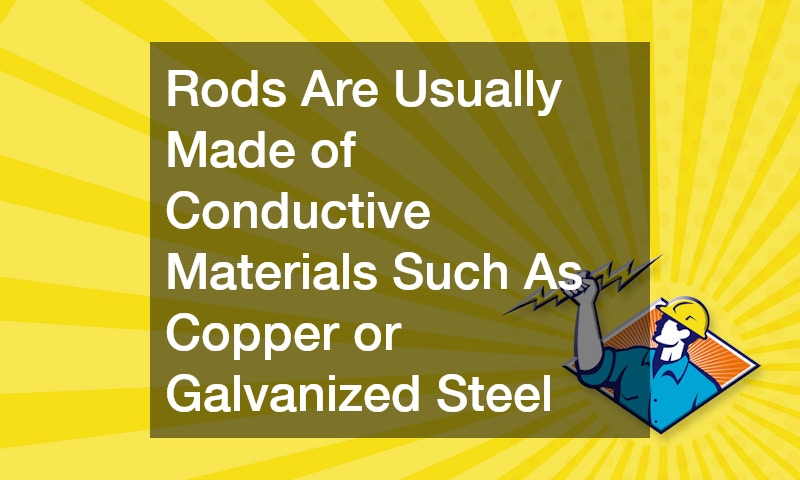The Easiest Way To Add Grounding Rods to Your Home
Grounding rods, also known as grounding electrodes, are essential components in the safety and efficiency of any electrical system. They provide a path for electrical currents to safely dissipate into the ground, protecting both people and equipment. By understanding how grounding rods work, homeowners can ensure their electrical systems are both safe and reliable.
Installing grounding rods properly can mitigate the risk of electrical surges and lightning strikes. These rods are usually made of conductive materials such as copper or galvanized steel, which are excellent for conducting electricity. A well-installed grounding rod can help maintain the integrity of your electrical system by preventing damage from unexpected voltage spikes.
While the concept is simple, the installation process requires careful planning and execution. Without proper grounding, electrical appliances can be damaged, and occupants may face significant safety hazards. Therefore, learning about the installation of grounding rods is an investment in both the safety and durability of a home’s electrical infrastructure.
Understanding the Role of Grounding Rods in Electrical Systems
The main function of grounding rods is to provide a safe and efficient pathway for excess electrical energy to be discharged into the earth. This is crucial in preventing electrical fires and ensuring appliances function correctly. Grounding rods act as a bridge between your home’s electrical system and the earth, neutralizing excess electricity safely.
In situations where a large surge of electricity enters the home, such as a lightning strike, the grounding rod dissipates the energy, minimizing the risk of electrical fires. This process safeguards not only the appliances but also prevents potential harm to inhabitants. Additionally, grounding rods help stabilize voltage levels, allowing your electrical system to operate smoothly.
Modern electrical codes mandate the use of grounding rods to protect electrical systems from fluctuations and failures. By dispersing potentially dangerous electrical surges, grounding rods maintain a steady state for the electrical system. Understanding their importance within electrical systems highlights the necessity of proper installation techniques to ensure maximum safety and efficiency.
Steps to Install Grounding Rods in Your Home
The installation of grounding rods begins with selecting the appropriate material and size. Copper and galvanized steel are common choices, each offering distinct advantages depending on the environmental conditions they will face. The rod’s length should be at least eight feet to ensure it penetrates deeply enough to maintain contact with conductive soil layers.
After selecting the materials, the next step is to choose an appropriate location for installation. This spot should be free from interference of pipelines or cables and ideally have moist soil for improved conductivity. Marking this area helps guide the rod’s insertion into the ground, making the process more precise.
Drive the rod into the earth using a hammer or specialized grounding rod driver. Ensure it reaches a depth where it remains firmly in place and touches moisture-rich layers for the best conductivity. It’s crucial that the rod is completely buried for optimal performance and safety compliance.
Connecting the Grounding Rods to the Electrical System
Once the rod is installed, connecting it to the home’s electrical system involves securing a grounding wire from the main service panel to the rod. This connection is typically made using clamps rated for grounding purposes to ensure a stable and lasting bond. The grounding wire should be of adequate gauge to handle potential electrical surges effectively.
It is important to regularly check the integrity of this connection, as loose or corroded fittings can impair the system’s functionality. Inspecting and maintaining these connections ensures that the grounding system continues to perform effectively over time. Routine examinations can prevent failures that could otherwise lead to electrical hazards.
For homes with pre-existing grounding systems, adding additional grounding rods can enhance safety. Employing networked rods can often provide more comprehensive grounding coverage, especially in regions prone to frequent electrical storms. Proper connection techniques are vital to integrating new rods into the current electrical safety system effectively.
Ensuring Compliance with Electrical Codes
Compliance with local electrical codes is essential when installing grounding rods. These regulations are in place to guarantee the safety and consistency across different electrical systems within a community. Before starting installation, familiarize yourself with local requirements to make sure your setup is compliant.
Local building codes typically specify the types of materials and installation procedures permitted. Inspectors may assess your system to verify its adherence to safety standards, ensuring that all components are installed correctly and that the grounding rods function as intended. Meeting these codes helps in safeguarding both the home and its occupants.
Ensuring compliance with established guidelines involves diligent research and possibly consulting with professionals. Practical advice and insights from experienced electricians can improve both safety and system performance. Investing time in learning and adhering to these codes can save future costs associated with non-compliance and system failure.
The installation of grounding rods is a crucial step in protecting a home’s electrical system from surges and lightning strikes. By understanding the role and proper installation techniques of grounding rods, homeowners can dramatically reduce electrical hazards. Grounding rods play an essential role in maintaining the safety and reliability of home electrical systems.
The process involves careful planning, selecting the appropriate materials, precise installation, and ensuring connections to the electrical system are secure and compliant with codes. Regular inspections and maintenance are needed to keep the system functioning optimally. It’s a small investment of time and resources that pays off significantly in safety and efficiency.
For anyone concerned about the integrity and safety of their home electrical systems, understanding and correctly installing grounding rods is a significant step. This knowledge not only protects the home but also ensures compliance with local safety standards, contributing to a more secure living environment. In conclusion, grounding rods are an indispensable component of a well-functioning electrical system, ensuring peace of mind for homeowners everywhere.



